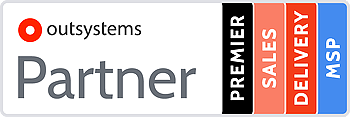What is the OutSystems low-code platform?
More and more companies are switching to low-code development. No wonder, as low-code offers interesting advantages in these times of staff shortages and rapid digitalisation. Unlike traditional software development – where developers write code from scratch – low-code uses predefined modules and templates to develop applications. This lets you build a software system with ready-made “blocks” of code. Companies cite these as the main reasons for choosing low-code:
Therefore, we also believe that low-code is the future of software development, in particular OutSystems’ low-code platform.
CoolProfs, your OutSystems partner

CoolProfs has been an OutSystems partner since the Dutch launch of the platform in 2009. We are the Dutch partner with the most OutSystems knowledge in-house and one of the few OutSystems Premier Partners in the world.
As an OutSystems partner, we help companies with their OutSystems projects. For example, we act as an OutSystems implementation partner. We support companies that want to take their OutSystems landscape to the next level and, for example, optimise their software development process. We also help companies that get stuck and need help to get their OutSystems environments back on track.
We see agile development as an absolute requirement for getting everything out of the OutSystems platform. We also regularly act as a partner in this transition.
Low-code leader OutSystems
OutSystems is one of the key players in the global low-code market. The originally Portuguese company was at the forefront of the rise of low-code, which at the time was still called Rapid Application Development, at the beginning of this century.
Soon OutSystems was recognised as a “Leader” in the renowned Gartner Magic Quadrant. Year on year, the low-code development platform expanded and became more innovative. The operation of the development platform is highly visual and allows companies to model both desktop and mobile applications, running in the cloud, on-premises or in a hybrid environment. Within just a few days, you can set up a compact mobile application. However, most companies use OutSystems to develop impactful, innovative (business) applications: from revamping and enhancing legacy software to the creation of a completely new system that brings about a true digital transformation.
Rapid application development with OutSystems
Speed is an obvious advantage of low-code development with OutSystems. Companies that have started working with low-code say they can develop applications 40 to 60% faster compared to traditional development methods. There are several reasons for this.
Improve your ROI with OutSystems
Low-code can significantly improve companies’ Return on Investment (ROI) and is therefore a frequently mentioned reason for making the switch.
We have already mentioned the high speed of the development and delivery process. In addition, choosing OutSystems can reduce development costs. Switching to low-code reduces the number of bugs in the newly developed software, so you incur fewer costs for bug fixes later in the process. Moreover, developers are quickly trained or retrained as OutSystems developers and new developers with less or no development experience are also productive faster.
With the right tools, OutSystems also lends itself perfectly to automated testing and monitoring of systems and the application landscape, resulting in fewer bugs and faster detection and resolution of issues.
Because software can be built faster and easier, the threshold is low to tackle more and more workflows in the organization. Department after department, a company becomes digitised with business applications that support all processes.
Low-code applications are often scalable and can therefore easily grow with the organization. As demand changes, OutSystems applications are often easy to adapt to new market conditions. This gives companies a unique advantage over their competitors.
Finally, due to the visual nature of the OutSystems platform, stakeholders can be involved in the development process from the start and can make adjustments when needed. The end product is more in line with demand and better meets the actual need.
When the business is better and more involved in the development process, more value is created. Stakeholders can literally take a seat next to the development team and look under the hood. As a result, colleagues see the possibilities and limits of software, and IT teams better understand the needs of the business. Instead of building what is requested, they develop the solution to the underlying problem. Our consultants know better than anyone that these are two different things.
When a company deploys low-code development in combination with an automated and standardised CI/CD pipeline, a strong boost of new value streams is created. IT teams can release software on a daily basis and deliver immediate benefits. Read more about OutSystems in combination with Software Development Life Cycle (SDLC) here.
OutSystems 11 and ODC
OutSystems 11 is the latest version of the platform, with better support for microservices, CI/CD and faster, smarter Reactive applications. AI is also playing an increasingly prominent role in the platform.
OutSystems continues to work on ODC – OutSystems Developer Cloud. This is an entirely new and highly scalable cloud-native development platform where apps operate within containers.
The strong and continuous power of innovation that OutSystems shows is one of the most important reasons why we believe in the future of low-code development. Are you interested in our onze Road to ODC? Klik hier!
